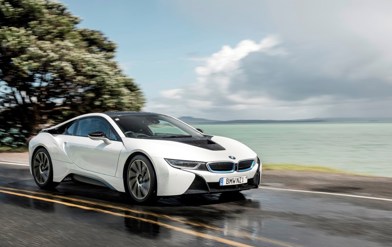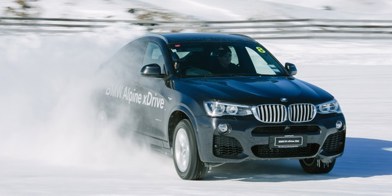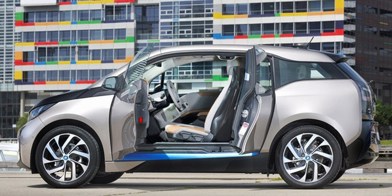The Mazda CX-60 PHEV is here, and we’re spending a bit more time with it.
Mazda’s large platforms got a boost in 2023, with the beginning of its new series of SUVs, starting with the CX-60. A new-ish look and feel, the mid-ship passenger cell, rear-drive platform and inline six-cylinder engine revives some of the past glory of sports car recipes in a large-scale SUV. CX-60 was the first to launch, along with CX-90, and more are to come.
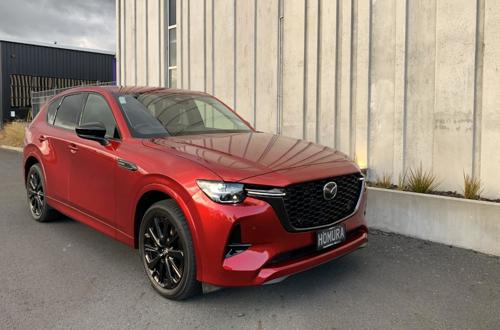
We first sampled the CX-60 back in Japan, focusing on the chassis, as the 3.3 diesel we drove wasn’t bound for NZ. It did officially arrive with a petrol 3.3-litre inline six-cylinder, and the fast 2.5-litre four-cylinder – made faster with the addition of Mazda’s first PHEV plug-in hybrid production car A 129kW motor boost the total to 241kW and 500Nm, also making it Mazda’s most powerful production model ever, usurping the likes of RX-7s and RX-8s. But as launches go (quick), we didn’t spend a huge amount of time with the CX-60, so we’ve got our hands on one for a couple of months.
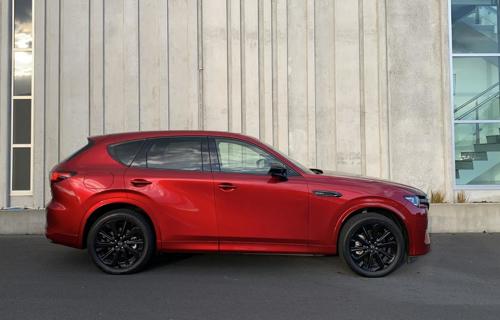
We reviewed it in November and highlighted its virtues and drawbacks, but will a longer term with the CX-60 PHEV flatten out the highs and lows?
We got our hands on the Homura, the mid-spec model, that’s $9k up from the entry Touring model (and $3k less than the Takami), and adds Black Metallic Alloy wheels, which really sets off the signature Soul Red paint, panoramic glass sunroof and a driver facial recognition system.
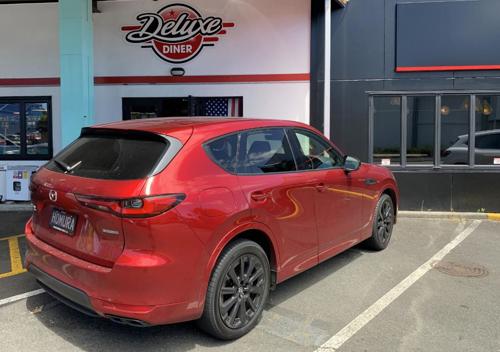
Fast and efficient are two attributes that don’t often gel, but the CX-60 is both: Mazda claims 5.8 seconds to 100km/h, and with a full tank (and charge), we rolled off back-to-back 5.95s.
It is on the coarse side, however, and when that 2.5-litre engine gets going, there’s a gruff cacophony sounding out. Select Sport mode in the M-Drive switch and it’ll certainly make itself known, and as it’s revving out to redline for hard acceleration, there’s no mistaking the petrol is burning.
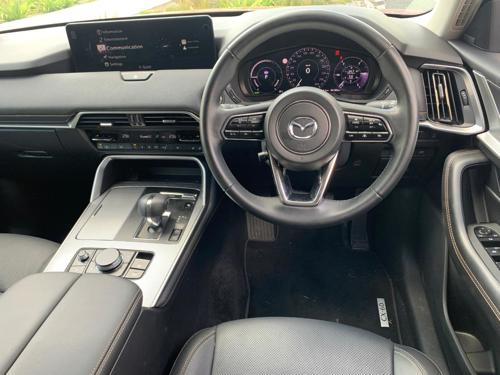
On the consumption side, Mazda claims a lowly 2.3l/100km, and we can only expect this to be the case with more charges and more EV-focused driving. But with that is a slight problem, that really isn’t. Charging the 17.8kWh battery at home, from flat, will cost in the region of $3-4, and that’ll really bring down the petrol use. But the ability to charge in the public can be challenging as the Mazda only uses an AC Type 2 plug: so at best, it’ll need a little over two hours on an AC charger – no CCS fast charging for the Mazda, which gets annoying at times when that’s all there is. Teasingly, there’s even a blank, where the fast-charging port should and would be.
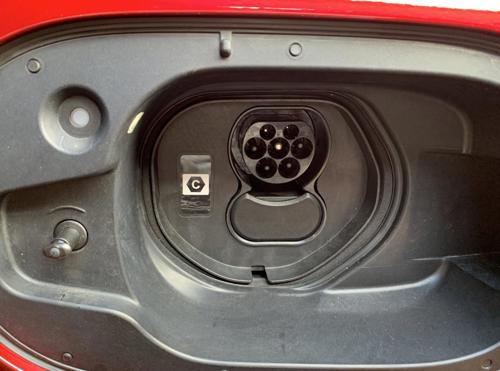
Given the AC charging only, the retention and use of that EV charge becomes a little more important, such as keeping the charge for low speeds and around town, and keeping the ICE engine for more efficient motorway use. There is a battery button near the shifter that saves the charge to a selectable level, and uses the ICE to charge the battery if it's below that threshold, but the recharging is very slow, so it's most efficiently used to maintain the charge rather than recharge: it takes around 100km of driving to put 20km of range back into the battery.
Total EV range is up to 63km, and we’ve seen around 50-62km as it puts priority on using its electricity first, though that often shows close to 23-25kWh useage, which is rather volt-thirsty. Still, volts are cheaper than petrol, so the appeal of the PHEV component of the CX-60 is a large part of its appeal.
At least until April 1, when the 40c/km RUC charge for PHEVs kicks in. It’s still a better idea to use EV (which can be manually selected), as the fuel tank is a modest (for a vehicle this size) 50 litres – and 8-litres smaller than the six-cylinder/non-PHEV.
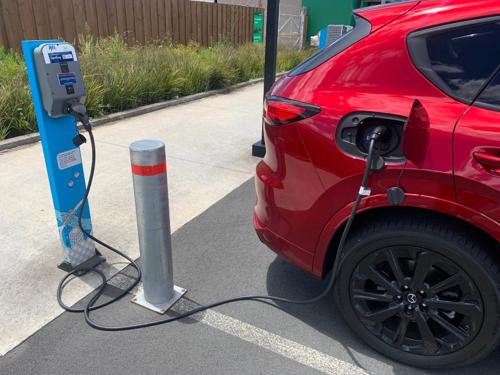
Cost wise, on a 40c/kWh AC public charger, it costs around $7 to recharge the battery from zero to full. That’s $7 per 50km, or $70 for 500km, a little less than half the cost of getting 500km from a tank of fuel, reinforcing that a home charge (around 20c/kWh) is the most cost-effective way to recharge the battery. Even with the added RUC cost of $53/1000km or $27.50/500km, that’s still $90 per 500km for EV use, or $120-$130 for petrol - or a 30 per cent saving. And then there's the back-up of the petrol engine, making the PHEV still a solid choice as an all-rounder.
Curiously, the electric motor assistance is not just an eco benefit, it’s also a necessity, as it smooths out the drivetrain, particularly at low speeds. It’s here where the CX-60 is least capable, often indecisive, chopping and changing between gears of serving up the infrequent clunk. The electric motor assistance – either in full EV or hybrid mode - smooths over a lot of these issues, offering a better 0-30km/h experience, with typical slow-moving throttle movements, both manual or when using cruise control.
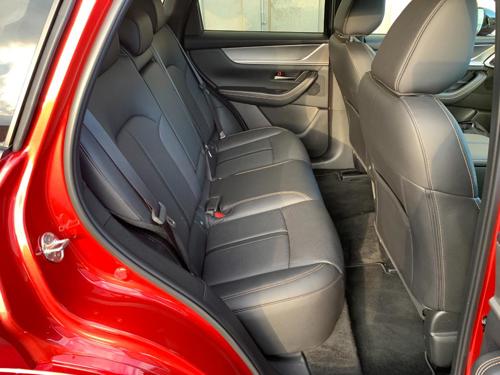
I quite like the touchscreen operation, which includes both a master control dial that falls to hand near the shifter, and a part-time touchscreen that works in selected screens, such as Apple CarPlay.
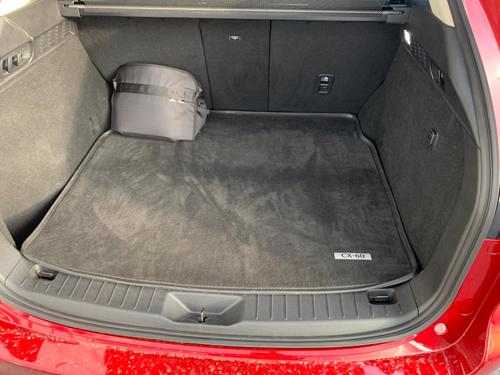
The size and storage and practicality of the cabin is great with lots of rear passenger room and a big boot, along with a quality fit, finish and feel of the premium interior.
After a few weeks, the character traits start to reveal themselves and the CX-60 is a solid machine, with its share of niggles: like the exterior door handle that needs to be touched a particular way and time to keyless lock the doors. The safety systems, that work well, can be a little too intrusive, even when in the least sensitive setting.
When charged overnight, the PHEV system works like a charm, making the CX-60 such a smooth(er), more practical and enjoyable machine. Even the odd shift pattern, with Park to the right of reverse, starts to work better, with forward-reverse more readily selected without checking the gate.
Remembering to press the fuel flap release certainly prevents a few profanities while doing the walk to the off-side for refuelling and finding it not opening - oddly, the driver-side EV charging flap simply presses to open.

And the whole infotainment system rebooting almost every time a phone is unplugged from a USB port has been a little grating.
Wireless phone charging, an electric/touchless opening/closing hatch and radar cruise control have all become daily delights to have and use, as is the ability to run on EV power alone for 50km a time to milk that petrol tank for close to 1000km.
We’ve got the CX-60 PHEV for another month, so we'll see how the volts flow.
MAZDA CX-60 HOMURA
ENGINE: 2.5-litre turbo-petrol four with 17.8kWh battery and hybrid
POWER: 241kW/500Nm
GEARBOX: 8-speed automatic transmission, AWD
0-100KM/H: 5.8 sec
CONSUMPTION: 2.3l/100km (3P-WLTP)
PRICE: $87,990
















